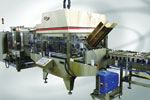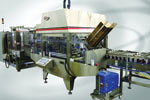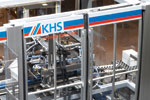
Rising petroleum and commodities prices often mean using less packaging material, which in turn demands more flexibility and accuracy in case packing systems.
Just about everything costs more these days. Because of narrowing profits, end users might have to be more cautious with their capital equipment purchases. Fortunately, today’s case packing equipment gives customers a lot of options. Questions of material, method and maintenance all factor in when considering such a purchase…and manufacturers are answering the demands with precision systems that gently handle today’s lighter weight, source-reduced packs.

Delkor's Spot Pak runs both the traditional 12-count distribution package, as well as retail multipacks, to create secure packs that use less secondary packaging material.
Sustainability spotlight
Sustainability concerns are causing packagers to rethink the amount of materials they use. With a struggling economy and both petroleum and commodities prices on the rise, packaging material reduction is more important than ever.According to Samantha Bishop, marketing manager at KHS, accommodating materials reduction is the number one demand from its customers. KHS is seeing smaller box flaps and thinner shrink film. Less corrugate and thinner plastic films/walls are making packages lighter and more fragile. This poses a challenge for machinery precision and flexibility.
“I think [material reduction] is a challenge for the machinery,” says Bishop. “You’ve got very little area for any mistakes. You can’t just push the flaps up; you’ve got to have more precision and flexibility.”
One way to reduce secondary packaging materials is to do away with a full case or a tray for primary packs that can support some stacking on their own. For example, Delkor’s Spot Pak machinery applies a temporary adhesive to a corrugated flat pad, which holds the product. After the product is placed, the pad is shrink wrapped in polyethylene film, keeping the product stable despite the substantial reduction of corrugate. (The machine supports running either a tray or a pad.)
Overall, the pad reduces secondary packaging waste by up to 70%. To put it simply, companies have to begin with the end in mind to focus sustainably.
According to Peter Fox, director of sales at Delkor, “Providing maximum durability for the product [is important] because if the product gets to the customer and it’s damaged, you’ve done nobody any service, and your sustainability score is going to go down.”
Another benefit of a simpler package is a simpler packaging operation to make it.
“Now we’re not pulling this great, big blank, folding it, gluing it, doing all of the other operations that you need to do to make a successful case packer work,” says Fox.

Keep it simple
As machines are becoming more sophisticated, simple operator interaction becomes a key consideration.“You can’t have a machine that’s so difficult to set up and tweak that [operators] just can’t get it right,” says Fox. “You have to have the ability for the operator to interact with it without being a machine expert.”
Automated diagnostics is becoming the norm on many case packing systems.
“Rather than calling up the HMI and making the operator go through a long list of choices, a machine will point to itself to indicate, ‘Look here for a solution.’,” says Fox.
Standard-Knapp’s upgraded Continuum system, for example, runs a diagnostic program that points out faults, as well as scheduled maintenance alerts. Like a patient telling the doctor where it hurts, the system is able to tell the operator where the problem lies. And, with English less likely to be the operator’s primary language, the case packer is more intuitive. Much like a printer or copier jam, the Continuum highlights the location of the problem, and makes the solution clear.
Of course, it’s best not to have a problem to solve at all. Standard-Knapp’s Zero-Gap infeed technology prevents any jamming on a variety of its machines, increasing machine efficiency to 98%.

A-B-C's Model 206 servo case packer offers motorized size adjustments to ensure repeatable accuracy and eliminate the tweaking that can slow changeover.
Serving up less space
Machinery is becoming less mechanical and more software-driven. In terms of installation, operation and maintenance, machinery manufacturers are making packers easier to run by adding more servos. This also significantly cuts down on changeover time, because the change isn’t mechanical, but just a touch of a button.“[A major innovation] would be the tool-less changeover between the different case and bottle sizes,” says Bishop. “We are moving away from our machinery being very mechanical, and we are now replacing that with servos. That gives us a precision and repeatability, which really helps in the efficiency of the machine.”
In general, case packers that have been designed around servo motor technology typically have the added benefit of a smaller footprint. Case packing machinery designers are delivering on this, too, with compact and modular systems.
Space limitations on packaging lines are calling for more flexibility from individual machines; that means smaller machine sizes and multiple modules. While companies are making entire machines smaller-such as A-B-C Packaging Machine Corp., which offers its Model 206 Case Packer at 15.4 linear feet on the production line-some floorspaces are so confined that machines need to be able to work around walls and corners, and separate modules bring a strong response to these space conundrums.
Fox describes multiple-module machines as having the ability to be laid out so that tray- or case-forming can be done remotely, and even delivered to the loading system by means of a hole in the wall, or around a corner.
“We can make what appears to be pretty crazy layouts when [machines] sit on our floor, but once you visit the plant, you recognize why we had to do what we did,” says Fox.
Delkor’s Spot Pak systems offer multiple modules, allowing a customer to select particular modules to run or not to run, which also allows for quick changeovers.
Often, another benefit of a modular machine is faster delivery times. But KHS goes even one step further with its WP 030 wraparound tray packer. Yes, the modular system has a compact footprint and, yes, it is designed for quick delivery anywhere in the world due to the company’s global network. (It has manufacturing locations in the U.S., Germany, India, China and Mexico.)
But the WP 030 is also affordable, as Bishop explains: “We at KHS are working on standardizing our frames and machine components to help keep costs down for us and our customers.”
With the Economic Stimulus Act of 2008 encouraging Americans to purchase American products to boost the economy, as well as consumers still being concerned with “going green” and wasting less material, case packing machinery makers are taking a strong initiative in responding to customer concerns and demands. Accommodating cases that use less material, fitting in tight spaces and speeding up global delivery are smart solutions. F&BP
FOR MORE INFORMATION
The following companies helped with the research of this article:ABC Packaging Machine Corp.
727-937-5144
Delkor Systems Inc.
800-328-5558
KHS
941-359-4000
Standard-Knapp
860-342-1100
